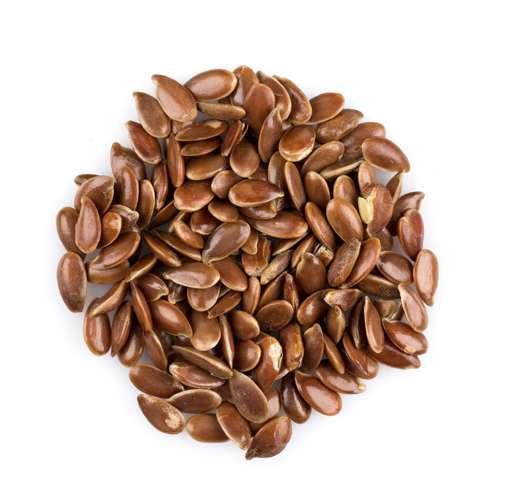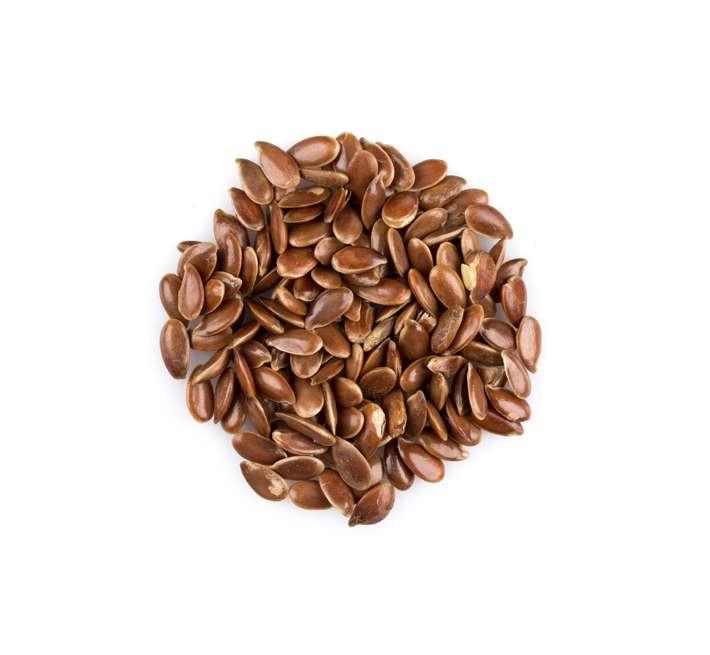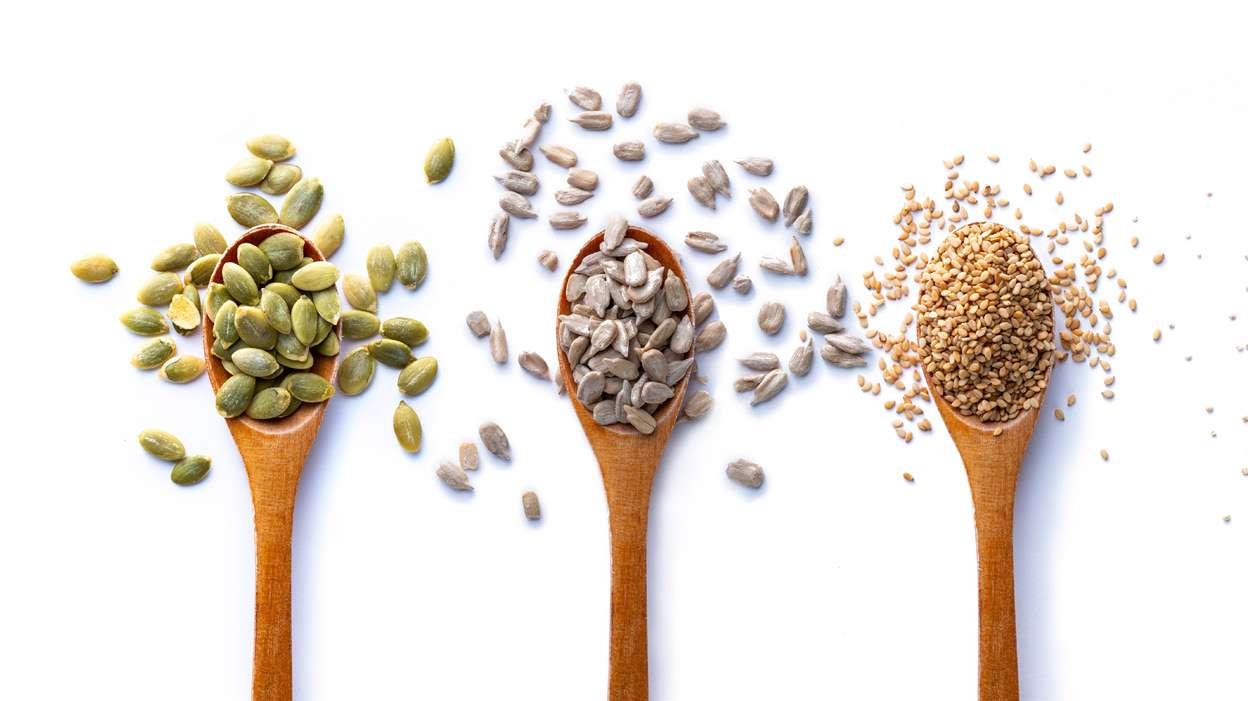
5 minute read
Myth Buster: Seed Cycling
SEED CYCLING MYTH BUSTER:

Advertisement
Can downing a couple of teaspoons of flax seeds at just the right moment help balance your hormones and dampen PMS? We asked the experts.
WRITTEN BY EMILY SMITH
When it comes to dieting fads, we have seen a lot, if not it all. Skinny teas, expensive whey proteins dressed up as meal replacements, 100 bananas per day and now the latest hashtag: seed cycling. It supposedly works by alternating different types of seeds into your diet during each phase of your menstrual cycle, providing a dose of essential fatty acids and nutrients to support hormone health, balance oestrogen and progesterone levels, and reduce the symptoms we all dread – from PMS to pain. But could the answer to deflating the bloat and balancing your emotions really be as simple as dumping a few seeds into your morning smoothie?
Hormonal imbalance is in the spotlight Hormonal imbalance is becoming more and more common in women of all ages, says Accredited Practising Dietitian and Nutritionist, Stefanie Valakas. The causes? Well, it varies. “Hormones are really important, and keeping them all in check, including those that affect the reproductive system, is like ensuring every single instrument and string in a large orchestra are in tune so the piece of music sounds just right,” says Valakas.
“Concerns about reproductive hormones are common, from polycystic ovarian syndrome (PCOS) affecting 12 to 20 per cent of women, and endometriosis making up another 10 per cent of Australian women of reproductive age, not to mention those who just struggle with irregular or heavy menstrual cycles for a range of other reasons, too.”
Poor diet, environmental toxins, including perfumes and plastics, and stress can all play a part in hormone imbalance, says Naturopath Dina Savitz, which can also cause symptoms such as fatigue, depression or anxiety, mood swings, body or joint pain, difficulty sleeping, headaches, infertility, low immunity and hair loss. While saliva and blood tests that assess levels of sex hormones are available from an endocrinologist or gynaecologist, diagnosing the problem hormones can be a complicated and expensive process, let alone treating the issue. So it’s little wonder women go searching for an easier and cheaper solution.
Seed cycling has become so popular on the interwebs, says Valakas, due to a modern awareness of the importance of hormones and a craving for natural alternatives to menstrual issues.
“Every woman wants a simple way to have better periods, whether that’s more regular, lighter periods or less of the not-so-fun associated symptoms such as skin problems, including pimples and acne,” she explains.
“Seeds are incredibly nutritious, so it’s a believable concept that different sets of nutrients at different times may help to improve cycle health.”
Seed cycling 101
While protocols vary, a quick Google has seed cycling advocates stepping out the process for willing experimenters. Essentially, you ingest one tablespoon of a different seed every day depending on where you are in your menstrual cycle, explains Valakas.
DOSAGE = 30g to 100g, according to the small studies that have been performed on the benefits of seeds for menstrual regulation.
WEEK ONE: During the follicular phase, beginning on day one of your period, you incorporate one tablespoon of flax seeds daily.
WEEK TWO: During the second half of the follicular phase and leading up to ovulation, eat a tablespoon of pumpkin seeds daily.
WEEK THREE: The day after ovulation begins marks the beginning of the luteal phase, and this is when you down one tablespoon of sunflower seeds every 24 hours.
WEEK FOUR: The second half of the luteal phase has advocates prescribing you one tablespoon of sesame seeds every day.

The fine print So what about the science? Put bluntly, the research is minimal and sketchy at best.
Proponents claim that part of the reason seeds work is because of lignans – the polyphenols found in plants, and in higher doses in sesame and flax seeds. These antioxidants support the immune system and assist in managing oestrogen levels, as well as reducing the stress hormone cortisol. Too much cortisol, and you set your body up for fat storage, muscle wastage, mood changes and more (more info on p. 49).
So does it work? Both Valakas and Savitz consider the research too inadequate to draw conclusions and so are hesitant to recommend seed cycling to clients. While it probably won’t do you any harm, there’s no evidence to suggest seed cycling has a significant benefit for hormonal health or balancing hormones.
“However, I do encourage women to eat a mixture of nuts and seeds each day – just 30 grams or a small handful can be a wonderful addition of healthy fats and some plant protein, as well as fibre for a healthy gut,” adds Valakas.
Early studies in women have shown flax seed intake may improve the regularity of the menstrual cycle and even promote ovulation by increasing the length of the luteal phase – the phase after an egg has been released, and where progesterone and oestrogen levels rise. But before you get too excited, both the oestrogenpromoting and hindering effects of these lignans were found to be minor; the lignans were more effective in preventing cancer than in regulating hormones, and the study was very small, looking at just 18 women with a regular cycle. “Each nut or seed has a unique profile of nutrients, so mixing them up is a fantastic way to get a wider variety of nutrients into your day.”
Valakas says the idea of seed cycling can easily become another ‘food rule’ women feel they should be following, without any scientific backing.
“I think it can contribute to unnecessary stress, and can really be stopping women from seeking advice from their GP and gynaecologist about any concerns they have about the menstrual cycle and reproductive health,” she says. Savitz agrees, noting that while the practice might work for some, it isn’t enough for all (or even the majority) of women to achieve balanced hormones.
“It can cause a lot of stress, especially if a woman doesn’t know if she’s ovulating or not. Also, many women are regularly taking the contraceptive pill and therefore not ovulating at all, so this won’t work for them,” she says.
“I’m more likely to recommend clients increase their overall seed intake throughout the month, rather than be strict about cycling the seeds at certain times.”
Other solutions For those with imbalances or irregular periods, seed cycling is unlikely to be the most effective way of improving symptoms. Valakas suggests speaking with your doctor, gynaecologist or endocrinologist (hormone specialist) and an accredited practising dietitian, who focuses on women’s health, to work through the lifestyle factors that may be affecting your hormone health.
Savitz also recommends ensuring you’re taking adequate doses of nutrients essential for healthy hormone production, including magnesium, zinc and selenium. S










